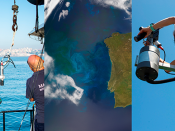Por Emanuel Dutra (Instituto Português do Mar e da Atmosfera, Lisbon, Portugal).
Land surface temperature (LST) temporal and spatial variability carries a blueprint of the surface energy budget. The temporal variability of LST is mostly dominated by the diurnal cycle of available energy, modulated by cloud presence, and synoptic variability. Averaged over a few weeks, LST filters the cloud and synoptic variability, remaining the diurnal cycle. On these time scales, the daily maximum of LST spatial variability will be mostly dominated by the land surface conditions (e.g. elevation, land cover, vegetation state, soil moisture state, etc.). Therefore, the LST spatial variability of the daily maximum should reflect the different sources of land surface variability, making it an optimal candidate for evaluating the realism of Earth System models in representing such surface heterogeneities. Moreover, LST is also one of the few land surface variables that can be directly derived from satellite data, and there are several available datasets which provide high quality and long data records. In this presentation I will give a brief overview of the representation of the surface energy balance in numerical models used for numerical weather prediction and climate simulations and the satellite retrievals of LST. Several examples of the use of satellite LST will be presented, including the impact of the revised land information in the ECMWEF IFS model for numerical weather prediction and in high resolution global simulations.




















